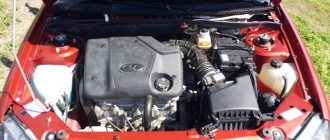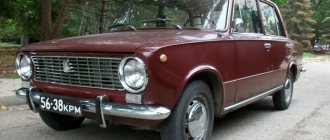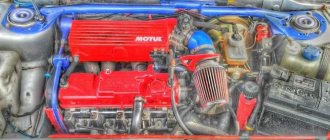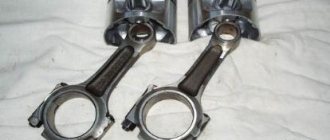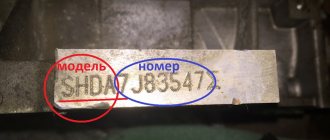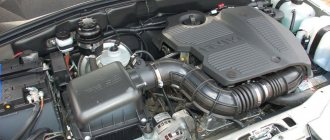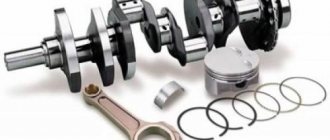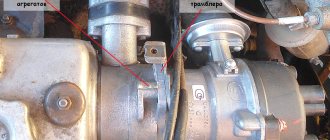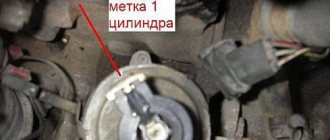Engine power: how it is measured
Speaking about the concept of “engine power”, it is important to note that for it there are not only different units of measurement, but also different methods of measurement, and each of these measurement methods demonstrates a different result.
Important
The standard measurement method is the one that uses kilowatts, which is used in most European countries. But when the power of the power plant is given in horsepower, the measurement methods may vary depending on which particular country we are talking about.
Thus, in Japan and the United States, two types of indicators are used for this:
- Net. This means testing the motor on a stand, moreover, a motor that is equipped with everything that is necessary for full operation of the vehicle - muffler, fan, generator, etc.
- Gross. This method is usually used to test power plants that are not equipped with additional units. Gross power is 10-20 percent higher than net power.
DIN. This method of calculating power was introduced by the German Institute for Standardization specifically for measuring the performance of motors with the so-called. inseparable equipment that is present in the machine by default. In this case, we mean the cooling system pump and fan, no-load generator, fuel and oil pump.
Torque, its relationship with power
Both of the above-mentioned units of power measurement (horsepower and watts, and to enlarge the indicators of the latter unit it is customary to use the concept of kilowatt) were invented by J. Watt, but the car is driven by torque, measured in Newton meters. Why doesn’t its ability to move depend on the engine power of a car?
Power and torque are closely related characteristics: power, measured in watts, is an example of torque multiplied by 0.1047 and rpm.
In other words, power shows the amount of work performed in a specified period of time. Torque demonstrates the engine's very ability to do the job.
For example, if a car gets stuck in a swamp and stops moving, the engine power is zero, because no work is performed, while the torque is present even though its indicators will be minimal, insufficient to start moving. Thus, there is torque without power, but not vice versa.
In practice, the speed performance of a vehicle directly depends on power: the higher it is, the faster the car can move. Torque (also called “moment of force”) is an indicator of the rotational force of the crankshaft and its ability to resist rotation. The engine's high torque is most evident during acceleration or when driving in difficult conditions, when the engine withstands critical loads.
Another important indicator reflecting the capabilities of the engine is the speed range when the greatest thrust is achieved. Also important is the elasticity of the motor, that is, its ability to develop high speeds under heavy load. This refers to the relationship between the number of revolutions for the highest power and for achieving the maximum possible torque.
This affects the regulation of driving speed using the accelerator and brake pedals without using the gearbox, as well as the ability to drive at low speeds in higher gears.
So, for example, thanks to the good elasticity of the engine, the car in 5th gear will accelerate from 75-80 km/h to 120, and the faster this happens, the more elastic the power plant. If there is a choice between two motors with the same volume and power, then the one that is more flexible is better, because it is more economical, quieter in operation, and has greater wear resistance.
Power and torque
Power and torque... These terms often confuse many visitors to automotive forums. Enzo Ferrari once said, “Horsepower sells a car, torque wins the race.”
We are not going to present here all the equations and formulas that allow you to calculate power and torque: it is quite difficult to explain many things in one article. Yes, you won’t need this, unless, of course, you plan to become a major specialist in this field. But we will try to explain in clear language how power and torque relate to each other and how they affect the performance of the car.
Horsepower
The term "horsepower" was first used by James Watt, a British inventor whose name is inextricably linked with the creation of the steam engine. Strictly speaking, horsepower is the speed at which work can be done. Watt used the term to compare the power of a steam engine to that of a workhorse. Along with horsepower, the system unit of power measurement used today is the watt (W).
1 hp = 746 W
The effective engine power is measured at the crankshaft using a dynamometer. Car manufacturers typically use the term "peak power" (maximum power at a certain number of revolutions per minute) to refer to it.
Horsepower is calculated by multiplying the engine torque by the RPM and then dividing by 5252. Where does the last number come from? If you don't want boring and confusing explanations, just take my word for it and remember this constant.
torque * angular velocity (RPM)
power = —————————————————
5252
It would not hurt to mention roller dynamometers here, but due to the wide variety of dynamometers available, we will describe the main ones in another article. It should be noted that there are many reasons why the numbers observed when driving on the road are lower than those obtained on the stand. The car is stationary on the stand, but on the open road air pressure, temperature changes and many other factors contribute that are difficult to take into account during testing, although many try to compensate for their absence with fans, etc.
Torque
Torque is the rotational force that will be applied to the drive wheels of the vehicle. Torque can be thought of as a measure of the engine's ability to do work. Torque units are lb*ft and Newton*meter (Nm). One foot-pound of torque is the force required to turn a 1-foot axle that has a 1-pound weight attached to the end. If there is a 200 lb weight at the end of a 1 foot axle, the torque will be 200 lb*ft. Obviously, the higher this number, the greater the rotational force on the wheels.
1 lb*ft = 1.36 N*m
However, it is important to understand that as your engine torque increases, the likelihood of your wheels turning spontaneously increases. This is a fairly common occurrence in high-torque, high-performance front-wheel drive (FWD) vehicles. Since the front wheels are also involved in steering the vehicle, you may experience an effect called parasitic power steering. In principle, the problem of “disobedience” of the drive wheels is characteristic not only of front-wheel drive cars, but of any powerful car with high torque. However, by dividing the torque to all four wheels (in the case of four-wheel drive (4WD) vehicles), you can reduce this effect and put more power to the road. Although there are many more factors (such as tire size and structure, suspension and chassis tuning, gear ratios) that can help front-wheel drive (FWD) or rear-wheel drive (RWD) vehicles make good use of their power.
Comparison of power and torque
(How power and torque affect performance)
The reason for the misunderstanding of a number of issues by car enthusiasts lies in the fact that manufacturers, as a rule, cite peak power figures as a characteristic of a car engine. This leads to confusion, people try to compare the performance of a car with its horsepower. “My car has more horsepower, so it will be faster than yours” is an incorrect but fairly common comparison.
There are many factors that affect a car's performance, and torque is certainly one of them. In addition, both power and torque will depend on the gear ratios. And, of course, how and for what the car is used plays a big role.
If you've ever driven a high-torque car (like a big-displacement car or a turbodiesel), you've probably noticed that you're able to accelerate through most gears with ease. This is a result of the fact that there is enough power available in the form of torque to propel the car over a wider rpm range. Acceleration is directly proportional to torque, i.e. the machine will accelerate according to the torque curve.
However, if you use a numerically higher gear ratio to increase torque, you are actually reducing the maximum rotational speed of the drive. This can cause a car with high torque (say 680 Nm) to reach its limit already at 30 km/h.
That said, talk of torque isn't just a play on words. Understand that horsepower is simply another way of measuring power (remember the equation above: horsepower is torque multiplied by angular velocity divided by 5252). However, the engine can be designed to produce higher RPMs and more power and thus produce more torque.
From the above, it follows that horsepower and torque are related to each other, but they are not the same thing. A car with more torque will accelerate differently than a car with more horses under the hood, with different shift points and rpm ranges. Cars with less torque (more horsepower) tend to rev more, but maximum power is only achieved at higher rpm. Cars with more torque (less horsepower) have less power but a comparatively wider rpm range. Everything is very confusing: it seems that torque and horsepower are the same thing, but they accelerate the car in different ways. A good car can be considered one that has an optimal ratio of torque and horsepower and the ability to increase both parameters.
What else affects acceleration?
- Vehicle weight . Many people mistakenly believe that the more a car weighs, the more energy is needed to move it.
- Aerodynamics . Again, a lot of energy is required for the machine to overcome the resistance of oncoming air flows.
- Rolling resistance . Tires and drives (gears, drive shafts, axles, etc.) require energy to be able to rotate on contacting surfaces.
- Gears/transmissions . In order for the car to accelerate and accelerate, it is equipped with a gearbox. The gears in the box affect the torque transmitted to the drive wheels, but they cannot change the amount of horsepower in the car. In a transmission, it all starts with a gear that produces torque. It allows you to accelerate at a relatively moderate pace, but avoid rapid engine revs. Each subsequent gear helps to develop speed. This is why a car, for example, can accelerate from 0 to 96 km/h in 5 seconds, but from 0 to 160 km/h will already take 13 seconds, since it needs another 8 seconds to reach the additional speed of 64 km/h. It is important to take into account kinetic energy and aerodynamics (wind resistance).
The dynamometer records good torque not only at low revs, but throughout the entire rev range. Combined with a steadily increasing horsepower curve, this engine allows the car to accelerate and press the gas pedal all the way. Although, it all depends on the drive and equipment of the machine itself. But overall, it has good power and dynamics.
I hope that after reading this article about horsepower and torque, you will not confuse these two concepts. The main thing to remember is that a car with very good acceleration is one whose engine can produce consistently high power, even at the highest speeds. For example, the VVT-i timing system is effective for small engines, it helps optimize power at variable speeds. It doesn't really matter whether a car has a lot of horses or a lot of torque, because there are many other factors that affect its performance.
Acceleration Again, let's not bore you with boring technical terms, but let's just do some math. The engine torque depends on the gears in the gearbox. It increases as you shift to another speed. On a vehicle with low torque, it can be increased by changing the gear ratio. As a result, the transmission or drive ratio changes the engine speed range as well as how the torque is used (don't judge this during the process). A V8 and Vtec produce torque in different ways through gearing. These methods depend on the engine design.
With all this, it is interesting, as mentioned earlier, that a car that picks up speed well has good torque dynamics, which extends over the widest rpm range (a high rpm range helps maintain maximum torque). To get the most out of your car, you need to know what the power dynamics look like and what the engine speed is in each gear. You also need to know how the engine speed changes when the gear changes: upshift or downshift. This will help you know what the torque dynamics are in each individual gear. The car accelerates strongest at the peak of torque, but once you shift, the revs drop and the torque wanes. The whole trick is to find at what speed there will be good torque in the next gear, without losing dynamics in the current one. Of course, a lot depends on the car and its driver, but there are the most general recommendations. So, if your car produces maximum torque at 4000 rpm, and you don't want to shift to the next gear from there because you think you'll lose those valuable revs now and won't be able to maintain the same torque in the next gear, and therefore the speed movements. The general recommendation in this case is to shift for maximum acceleration when the tachometer needle hits the red mark (some cars and racing cars have special indicators).
Designation of car power in horsepower American cars
Horsepower (HP Gross) Until 1972 in America, car engine horsepower was measured in the following way: an engine was bench tested that was not equipped with an air filter, exhaust system or emissions control system, but sometimes equipped with a manifold. As a result, the maximum power and torque figures reflected only theoretical values, but did not demonstrate the actual engine power. In this way, the total engine power was measured.
Horsepower (HP net) After 1972 in America, net engine power began to be measured. With a fully completed and installed engine, flywheel power was measured, but shift losses were not taken into account.
Remember that American cars are equipped with large CU engines that produce high torque and ensure high performance of the car.
Horsepower (bhp) Power is measured in horsepower using a dynamometer. The measurement takes place on a test bench at the point where the shaft exits the engine (the crankshaft that connects to the flywheel). The final figure is derived from torque, which is used to calculate horsepower (bhp). Please note that the PS horsepower rating used in Germany is different from the bhp designation. Many manufacturers use the PS value for BHP horsepower. Approximate values:
- 1 Bhp = 1.005 Hp (net) – (the difference is not significant)
- 1 Bhp = 1.0187 PS
- 1 PS = 0.986 Hp
- 1 Hp = 1.01387 PS
Sometimes confusion occurs because some people talk about horsepower measured by a dynamometer, others talk about horsepower measurement taking into account losses, and others talk about the WHP wheel measurement method.
Power plant speed
When indicating the technical characteristics of a vehicle, there is the concept of not only torque, but also engine speed. It is possible to understand how they are connected to each other only by understanding the very nature of the internal combustion engine, and it is a unit in which the chemical energy of the fuel burning in the working area is converted into mechanical work.
So, due to the ignition of the fuel mixture, the piston begins to move, entailing cranking of the crankshaft. It turns out that the alternating cycles of expansion and compression that occur activate the mechanism, and it ensures the conversion of piston movements into crankshaft revolutions.
This allows us to conclude that the main characteristics of any vehicle are the torque and engine power plus revolutions when the required indicators are achieved. The concept itself refers to the number of revolutions per minute performed by the crankshaft. Power and torque are variable quantities that are directly affected by the number of revolutions.
To calculate power, experts use conventional mathematical calculations, in particular, there is a formula for torque through power, which looks like this:
Where
- M - torque;
- n is the rotation speed, measured in revolutions per minute;
- w is the angular speed of the shaft rotation.
Many people have a completely logical question about why measure power through revolutions and torque. In fact, this is important for a number of reasons and in many cases, in particular the development of an engine torque curve - a mandatory procedure in the development and certification of every new power plant.
The data obtained is needed for possible further improvement of the engine and achieving maximum performance characteristics. Thanks to periodic taking of all the required measurements and drawing up a schedule, the actual technical condition of the engine can be assessed.
What's more important?
The key achievement or main goal of any working motor is traction, for which thermal energy is transformed into mechanical energy. High traction performance is more characteristic of power units running on diesel fuel, which are characterized by a large piston stroke.
The high torque in this case is negated by the relatively small maximum permissible number of revolutions - this is a special solution by the designers in order to increase the service life of the motor.
Gasoline units are characterized by a higher number of revolutions, as well as a certain roll towards power, and this is due to the lightness of the parts and a low compression ratio. To be fair, it should be noted that every year both types of engines (both diesel and gasoline) are being improved, so they are becoming closer not only from a design point of view, but also in terms of performance, but the simplest rule of leverage still remains: if the force is greater, the speed is lower and the distance is less and vice versa.
No one can definitely say what is more important - power or torque, because both indicators are important.
Important
Cars with high engine power are capable of reaching higher speeds, and their speed range itself is noticeably higher, but a car with high torque accelerates to the first hundred much faster.
Since power increases with increasing torque, those power plants with higher speeds are usually characterized by a larger number of “horses”.
Here it is advisable to mention the concept of operating range - the distance, so to speak, between extremely high torque and similar power, when the engine operates most efficiently and demonstrates high performance combined with economical fuel consumption.
Car acceleration
The torque in the motor depends on the number and parameters of gears in the gearbox. During the movement, when moving to an increasingly higher speed, the torque will increase. If the car initially has a low engine torque number, it can be increased by changing the gear number. When switching, the engine speed limit changes through the drive coefficient. Depending on the design of the transmission, various (usually gear) gears are used for stable transition to high speed, acceleration, acceleration without a sharp reduction in torque.
If the car picks up speed well, we can talk about optimal torque dynamics, which extends over a wide range of operation. In order for a car to show maximum speed, you need to know exactly how the engine power dynamics change in each gear, how the speed changes when changing gears.
The car accelerates best at the peak of torque in a certain rev range. When switching to the next gear mode, the speed decreases and the torque decreases. Conditions that always affect the acceleration of a car towards a decrease or increase in speed:
- Machine weight. It is a mistake to assume that heavy SUVs are more difficult to accelerate.2. Transmission gears. The gearbox is the main element of the transmission, which transmits engine torque to the wheels.
3. Resistance. All transmission elements, tires, and engine parts experience friction and inertia.4. Aerodynamics. Resistance to oncoming traffic always prevents rapid acceleration.
